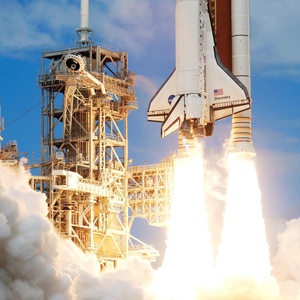STS-78 was the fifth dedicated Life and Microgravity Spacelab mission for the Space Shuttle program, flown partly in preparation for the International Space Station project. The mission used the Space Shuttle Columbia, which lifted off successfully from Kennedy Space Center’s launch pad 39-B on 20 June 1996.
The Space Shuttle is a retired, partially reusable low Earth orbital spacecraft system operated from 1981 to 2011 by the U.S. National Aeronautics and Space Administration (NASA) as part of the Space Shuttle program. Its official program name was Space Transportation System (STS). Five complete Space Shuttle orbiter vehicles were built and flown on a total of 135 missions from 1981 to 2011.

Space Shuttle Columbia (Orbiter Vehicle Designation: OV-102) was the first space-rated orbiter in NASA's Space Shuttle fleet. It launched for the first time on mission STS-1 on April 12, 1981, the first flight of the Space Shuttle program. Over 22 years of service, it completed 27 missions before disintegrating during re-entry near the end of its 28th mission, STS-107 on February 1, 2003, resulting in the deaths of all seven crew members.
Space Shuttle Details
Date of
Birth: July 5, 1952
Age: 72

Date of
Birth: Sept. 16, 1956
Age: 67

Date of
Birth: Aug. 12, 1951
Date of Death:
July 23, 2006

Date of
Birth: April 13, 1949
Date of Death:
March 19, 2023

Date of
Birth: Aug. 17, 1953
Age: 70

Date of
Birth: Sept. 19, 1957
Age: 66

Date of
Birth: Feb. 26, 1958
Age: 66
The National Aeronautics and Space Administration is an independent agency of the executive branch of the United States federal government responsible for the civilian space program, as well as aeronautics and aerospace research. NASA have many launch facilities but most are inactive. The most commonly used pad will be LC-39B at Kennedy Space Center in Florida.
INFO WIKIA batch of satellites for the Starlink mega-constellation - SpaceX's project for space-based Internet communication system.
Gaofen is a series of civilian Earth observation satellites developed and launched for the China High-definition Earth Observation System (CHEOS), a …
A batch of 20 satellites for the Starlink mega-constellation - SpaceX's project for space-based Internet communication system.
3 weather satellites performing atmospheric measurements using GNSS Radio Occultation for a Tianjin based company. Constellation is planned to have a…
Maiden Flight of the Ariane 62 launch vehicle, carrying ten cubesats, two deployers, five experiments, and two reentry capsules.
Türksat 6A is Turkey's first domestically manufactured geostationary communications satellite. It is to reside in 42° East orbital slot, providing se…
A pair of satellites officially described as for cartographic surveying purposes, details TBD.
Fifth flight of the Firefly Alpha small sat launcher, carrying eight cubesats for NASA's ELaNa 43 (Educational Launch of a Nanosatellite) mission.
A batch of 20 satellites for the Starlink mega-constellation - SpaceX's project for space-based Internet communication system.
The Advanced Land Observing Satellite-4 (ALOS-4) is a Japanese satellite designed to observe the Earth's surface using a phased array type L-band syn…